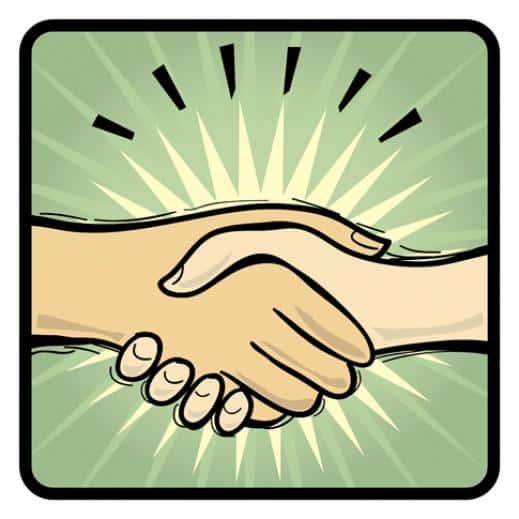
This blog post appealed to the editor of Sleep Savvy, our industry’s trade journal, who featured it as a guest editorial.
Nudging. Maneuvering. Manipulating. Schmoozing. Bamboozling. CLOSING. How great might it feel to give all that up, and sell even more successfully and happily?
I’m an odd “authority” when it comes to pitching consumers. I lived in a yoga community for 20 years. I didn’t watch TV or read magazines, and with an allowance of $1 – $3 per month, I rarely bought anything. When that chapter ended, with no resources and a family to support, I thought, “Maybe I can sell, if that’s what it takes.” So I signed up to sell satellite TV. (Natural fit, right?) Boy, did I tank. Things went better when I worked in a futon store, but I still didn’t feel like myself. Eventually I opened a small mattress store, and a few years later, founded Savvy Rest. We manufacture fine natural latex mattresses and we’ve done quite well—landing repeatedly on the “Inc. 500/5000″ list of America’s fastest-growing companies.
Back then, though, there was still this “selling” thing to take care of. I was baffled. What did I know about convincing people to pull out their wallets? The idea was anathema. Still, I needed to succeed. I listened to tapes and read books and blogs about selling, but something wasn’t sitting right. The techniques and programs I read about seemed manipulation based. The goal was always to take control, “close” the sale or maximize profit, and seldom seemed to reflect real concern for a customer’s needs. Not to mention that the whole role-playing thing was beyond me.
What did I know about closing? My yoga life had been all about opening—opening the heart to others, and opening the mind to the present moment. But maybe an unconventional background could still lead to a successful sales philosophy. I kept returning to what I knew, and ultimately found that what works for me, and for Savvy Rest, is what we call “Selfless Selling.” Here’s how it works.
Selfless Selling is a matter of intention. The first question in a sales situation is to yourself—is my goal to close a sale or to genuinely serve and have an authentic relationship with a customer?
It’s easy to check. Just relax and observe your thoughts when you’re with a customer. To the degree that you are tensely thinking about closing the sale or getting that profit or SPIF, to that same degree you’re not really present with your customer. Here’s a pressure-relieving thought: profit should be a by-product of your products’ benefits and your relationship with your customers, not the goal itself.
The truth is, it’s hard to have an authentic relationship with someone if you want something from them. And the more strongly you want something from someone, the more tense you become.
The inspiration behind Selfless Selling is that the only goal is to relax and have an authentic relationship with your customer. The relationship itself is the reward, and that liberates you both. What is best to fulfill their needs? Your customer is a human being with human needs. No one wants to be manipulated. If the products and information you offer meet the needs of your customer in that present moment, a sale will be the natural outcome. When everything is aligned, including some factors you can’t control, everything will unfold as it should.
If you make a sale just to score that sale, a few things happen that aren’t covered in most how-to-sell programs:
- You miss the opportunity to have an authentic relationship with another human being.
- Your customer misses the opportunity to have an authentic relationship with you.
- There is nothing in the experience that a customer might “pay forward” to another human being.
- You make no difference in someone’s life other than to sell them an object.
- You make no difference in changing the dominant values in our culture or our world.
There are several ways to practice Selfless Selling. For me, the best starting place is to relax, and then to recognize the vulnerability of a person who is coming into the store. After all, I am asking this individual, someone who doesn’t even know me, to lie down on a bed. Most people feel a little awkward; some may even be in pain. Then, I ask a few gentle questions and try to empathize with the need the person has, as if she or he were my family member, my friend, or my neighbor.
When I treat all customers this way, some of them will purchase; some won’t. Just as if I used manipulative sales techniques—some will buy; some will not. But if I treat everyone selflessly, I can stay relaxed. And I’m never left feeling that I’ve taken advantage of someone’s vulnerability. It certainly simplifies things. No mental contortions, just being present, trying to help, and getting myself and my fears of succeeding or failing —”closing” or “not closing”—out of the way. I believe that when customers experience this kind of encounter, odds are good that when they leave one of our stores, they’ll feel very differently about their mattress shopping experience.
It helps to remember that we are all vulnerable, and we are vulnerable together. Why forget this truth just because we are selling something? Selflessness is a powerful practice. The hardest part is letting go of all the contortions and techniques that so many salespeople are taught and earnestly practice. When you drop all that, it is very freeing.
Selfless Selling makes us all happier. Not just our customers, but our salespeople, too.